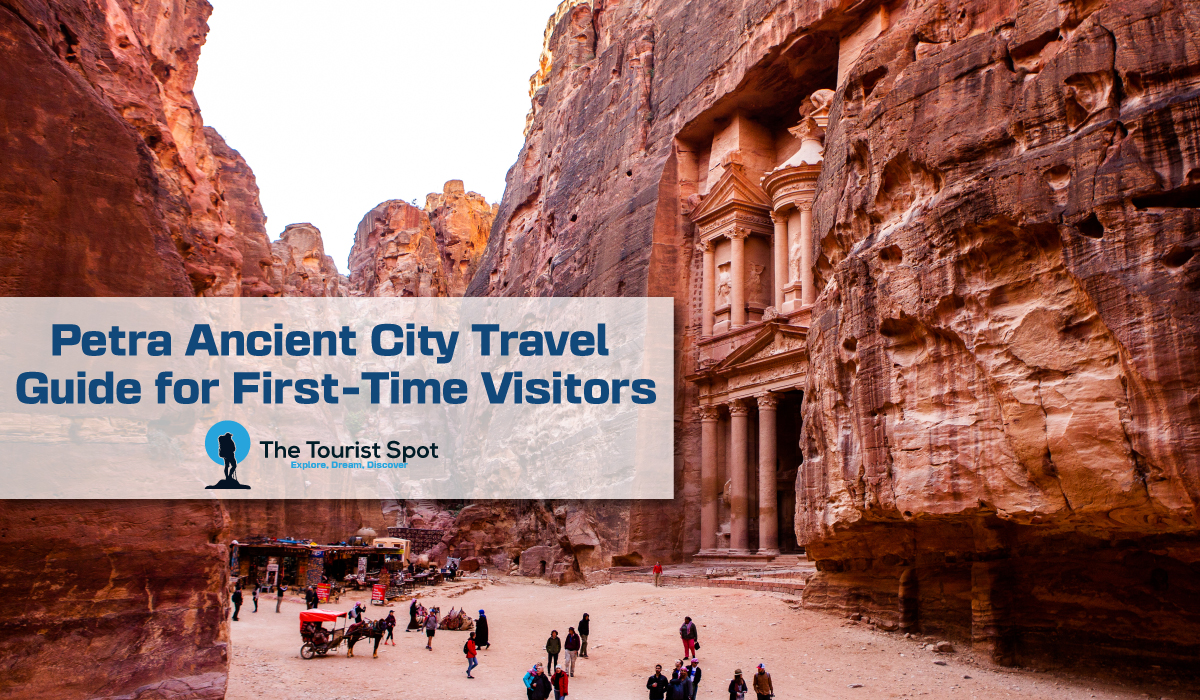Petra Ancient City is one of the most captivating historical destinations in the world. Carved into rose-red cliffs and nestled in the Jordanian desert, Petra is a UNESCO World Heritage Site that tells the story of the Nabateans, an ancient civilization known for their architectural and engineering brilliance. For first-time visitors, exploring Petra is not just a journey through stone but a walk through time.
If you are planning your first trip to Petra Ancient City, this guide will provide everything you need to know. From historical context and must-see monuments to practical travel tips, we aim to help you experience the site like a well-prepared explorer.
The History Behind Petra Ancient City
Petra was established as early as 312 BC and was the capital of the Nabataean Kingdom. The Nabataeans were known for their skill in water management and trade. Petra’s strategic location made it a major crossroads for camel caravans trading incense, silk, and spices between Arabia, Egypt, and the Mediterranean.
The city flourished until Roman annexation in 106 AD. Over time, due to changing trade routes and natural disasters, Petra fell into decline and remained unknown to the Western world until its rediscovery in 1812 by Swiss explorer Johann Ludwig Burckhardt.
How to Get to Petra
Most travelers arrive in Jordan via Queen Alia International Airport in Amman. From there, Petra is about a three-hour drive to the south. You can rent a car, take a bus, or book a guided tour. If you prefer comfort and convenience, private taxis or tour packages are available from Amman or Aqaba.
The main entrance to Petra is through the town of Wadi Musa. Here, you will find accommodations, restaurants, and transport services. The Petra Visitor Center is your starting point, where you can purchase tickets and hire certified guides.
Best Time to Visit Petra
Petra experiences extreme desert weather. The best months to visit are from March to May and from September to November when the climate is milder. Summer temperatures can soar above 40°C, making long treks uncomfortable.
Try to enter Petra early in the morning or later in the afternoon to avoid crowds and enjoy better lighting for photography. If your schedule allows, staying overnight in Wadi Musa and visiting Petra over two days offers a deeper experience.
Must-See Heritage Sites Inside Petra
1. The Siq:
The journey begins with a walk through the Siq, a narrow gorge flanked by 80-meter-high cliffs. This dramatic passageway leads you into the heart of Petra and sets the tone for what lies ahead.
2. The Treasury (Al-Khazneh):
Perhaps the most iconic structure in Petra, the Treasury features an ornate façade carved from sandstone. Historians believe it was either a royal tomb or a temple. Arriving at the Treasury after your walk through the Siq is a moment of awe for every traveler.
3. The Street of Facades:
This area showcases dozens of tombs with beautifully detailed facades. It reflects the Nabataean’s strong artistic and cultural traditions.
4. The Royal Tombs:
These grand structures carved into the mountain include the Urn Tomb, Silk Tomb, Corinthian Tomb, and Palace Tomb. Each showcases unique architectural styles that blend Nabataean, Roman, and Hellenistic elements.
5. The Monastery (Ad Deir):
A more strenuous hike leads you to the Monastery, another massive carved structure larger than the Treasury. The views from the top make the climb worth it.
6. High Place of Sacrifice:
This ancient altar offers panoramic views over the city and was used for religious rituals. Reaching this site requires a hike, but it offers solitude and insight into Petra’s spiritual significance.
Additional Experiences
Petra by Night:
If your visit falls on a Monday, Wednesday, or Thursday, consider attending Petra by Night. The Siq and Treasury are lit by thousands of candles, creating a mystical atmosphere accompanied by traditional Bedouin music.
Local Cuisine:
Sample Jordanian dishes such as mansaf, maqluba, and hummus in Wadi Musa. Many local restaurants offer a warm cultural experience.
Cultural Center:
Visit the Petra Museum or the Petra Nabataean Museum to learn more about the archaeological findings and Nabataean heritage.
Tips for First-Time Visitors
- Wear Comfortable Shoes: You will walk several kilometers on rocky terrain.
- Stay Hydrated: Carry enough water, especially if visiting in warmer months.
- Start Early: Avoid the midday sun and crowds by arriving as early as possible.
- Hire a Guide: A local guide can enrich your visit with detailed historical insights.
- Respect the Heritage: Avoid touching or climbing on monuments. Petra is a protected site.
- Carry Cash: Some local vendors and guides do not accept cards.
Petra and Its Global Significance
Petra Ancient City is not just a tourist attraction; it is a symbol of human creativity and resilience. Recognized as one of the New Seven Wonders of the World, Petra continues to captivate travelers, historians, and archaeologists. Its unique blend of natural beauty and human innovation offers a lasting impression on all who visit.
Whether you are a history lover, an adventure seeker, or a cultural explorer, Petra offers something unforgettable. Walking through its ancient paths connects you with a civilization that once thrived in the heart of the desert. The stories, sights, and serenity of Petra Ancient City create memories that will stay with you forever.
If you are planning a trip in 2025, make sure Petra is on your travel list. It is more than just a destination; it is a journey into the wonders of human achievement.

